During GASP’s time in CIT CCAD there have been informal encounters with students in other departments and programme but these have been limited. During the Expanding Realities Strategic partnership, we identified two main opportunities to pilot and evaluate engagement with both fine art under-graduate students and graduates of CIT CCAD and student art teachers.
This texts below explore engagement opportunities between fine art under-graduate students and graduates of CIT CCAD and artists working in supported studios along with reflection on the longer term relationships between a long-existing programme ‘Arts and Group Facilitation’ and with the MA in Art Therapy.
It also explores the engagement between student art teachers and artists working in supported studios.
GASP artists have been sharing space in CIT CCAD Department of Arts in Health and Community Practices since 2014. Over the years, collaboration with students has taken place on a number of levels, including, shared studio work and exhibitions, GASP artists facilitating in an Arts and Group Facilitation programme. As important as the formal encounters have been in the informal encounters of sharing space in the building, the encounters at lunch and coffee breaks and the everyday momentary encounters that come with sharing a space.
-Collaboration with CCAD Fine Art Students and Graduates
-Collaboration with Art Teaching Students on Professional Masters in Education programme in CIT CCAD
-Engagement with Master of Arts: Art in Process
-Engagement with MA in Art Therapy Department and programmes
-Engagement with Arts and Group Facilitation programme
Collaboration with CCAD Fine Art Students and Graduates
In May 2016 CIT CCAD and GASP hosted an international workshop for partner supported studio groups, AIM from Bristol and Debajo del Sombrero from Madrid.
This intensive week of collaboration between 3 studio groups was an ideal opportunity for fine art under-graduate students and graduates of CIT CCAD to immerse themselves in a collaborative experience and to consider the mutual benefits of collaboration and the sharing of creative space and processes.
A call was put out to CIT CCAD past and current Fine art students and six signed up to join the weeklong workshop
About the workshop
CIT CCAD and GASP wanted to create a workshop environment that would
a) allow each participant to achieve personal and artistic goals through the experience
b) maximise the opportunity of being in Cork and in a new environment to connect with the culture of the city and to avail of what it had to offer culturally.
Being the third of the series of workshops CIT CCAD and GASP had an opportunity to build an experience in Cork for each artists based on
-observation of their interests in the previous workshops
-one on one consultation with the participants and their support workers about what they would like to do in Cork
-follow up conversations by email.
The design of the programme was a conversation that brought together with artists interests with what could be found, offered and experienced in Cork.
A timetable was devised for each individual participating artist. A central base the open-studio was the home-base that everyone could meet in the morning and connect and then go off in ones, twos and small groups to engage in a range of experiences. A creative day trip out together was planned in the middle of the week to keep a connection between all the artists and the
organisation. This day trip was also a chance for people to both to make work and to share their work in progress.
Unique to this workshop was the bringing together or various Cork based artists and groups as well as the GASP artists. Three local guest artists working with various media, dance, sound and intermedia were invited to collaborate. CIT CCAD fine art students were also invited as well as a group of school children who were in engagement with the GASP artists on a project.
What Fine Art Students and Graduates Experienced
I had the opportunity to collaborate with some artists and engage with their making process, as well as create a collection of portraits representing them.
The chance to work in an open and fun environment with artists of various backgrounds and styles gave me new ideas in relation to my own art practice.
I was inspired by seeing how other artists worked and understanding their processes and methods. This has given me ideas of ways to develop my own creativity, for example through creative writing and use of sound.
The week was a unique opportunity to gain insight into other practices, through working alongside and talking to other artists.
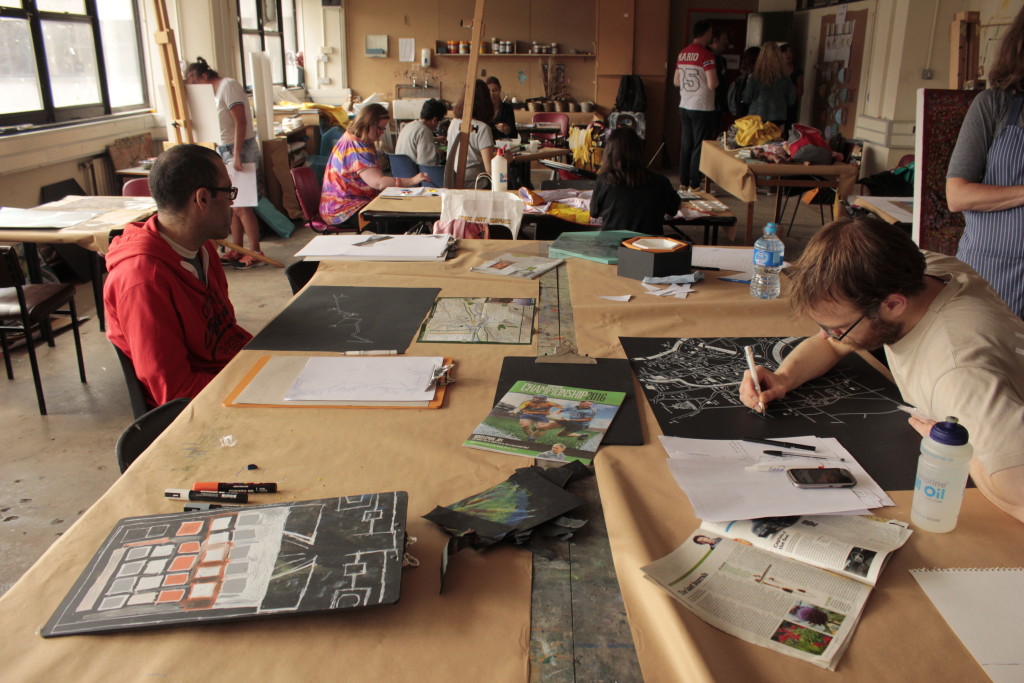
What Fine Art Students and Graduates learned
-Seeing how others approached their work and what techniques they used was beneficial for me as it opened up my mind to the endless possibilities of art, making me realize I could be less self-restricting when it comes to creating my own work.
-The week was a good opportunity to consider my practice in a different context, as I am used to working on my own in the studio, and it was an opportunity to work with others and even to work outside of the studio setting during the trip to Spike Island.
-It was a chance to see and understand international art programmes as well as Irish programmes and to see what is possible for an artist outside of the standard model of working in the studio and submitting work for gallery shows.
Overall I’m glad that I took part in this project because it has made me see how I could create work in a more relaxed studio based setting, without the worry of it being finished to a certain standard, like in college – or being assessed upon completion. I’ve also developed ideas that I am going to include in my own studio work.
What Fine Art Students and Graduates see as the benefits of collaborating with Supported Studio groups and the potential for future collaboration
As some participants might not have had any formal training, or if they had then it could’ve been a while ago – I see that it is beneficial to have the participation of current art students and art college graduates in the workshop as they can provide information on various techniques and approaches that the others might not have known about.
As the workshop took place in the college, I think to have students and graduates around possibly helps the participants to feel more at ease in the environment. It also helps to create links with the college which could prove useful in terms of access to college facilities for example, and also opens up the possibilities of future collaborations with the college and its students.
-As an artist I’ve benefited greatly from having this experience in an open art studio, where I could create freely without worrying about my work being evaluated. And having insight into the making process of other has also given me plenty of ideas and inspiration which is always a great benefit.
-I developed new confidence, new ideas and collaboration skills. Also, this was a very valuable networking opportunity to meet and work alongside artists from within Cork and from the UK and Spain.
-The art college can benefit from this as it creates links between individuals and organizations, opening possibilities for both the individual and the institution.
For the college it is always beneficial to have artists from outside the institution coming in as it opens up new ways of working to the college students and staff.
-For the college it is always beneficial to have artists from outside the institution coming in as it opens up new ways of working to the college students and staff.
-It brings a fresh energy and perspective to usual ways of doing things when there are people coming in from outside the institution. It would be lovely to see a similar project realized in the future, as having spoken about the project to a number of my peers I see a great interest in them wanting to participate in something similar.
-I think that for a lot of students in art college, programmes like Expanding Realities could be very useful in terms of developing students’ practices and to give them an insight into the possibilities that exist outside of the art college environment and as a way for students to engage with a wider range of people.
-A programme like this is also a way of showing students the value of art, when at times some students can become a bit jaded with the college system, and that there are different ways of working and practicing as an artist. It also proves the value in collaboration, which I believe is important for emerging and young artists to realise very early on in their development.
Collaboration with Art Teaching Students on Professional Masters in Education programme in CIT CCAD
The Expanding Realities Strategic partnership worked closely with the Perceptions 2016 exhibition to Share the work of the partnership with a particular focus on sharing the methodologies and outcomes of the workshop programmes alongside sharing the work of the individual artists practising in supported studios and outcomes of collaborative projects.
About the workshop programme
As part of the Erasmus+ Strategic Partnership workshops are being hosted by each of the partners as a means for them to share their approaches to their work with participating artists and also to test, innovate and evaluate their practice through engagement with partners with the benefits of an inter-cultural learning context.
The documentation of and reflection on the workshop processes is an important part of the learning for the partners as well as an opportunity to share with others practising in similar fields. There are six participating artists from each partner organisation along with a number of supporting/ collaborating artists in each workshop.
Each workshop was for 5 consecutive days. Debajo del Sombrero hosted the first workshop in Madrid May 2015 followed by AIM in Bristol in March 2016 and CIT CCAD and GASP in Cork in May 2016.
Sharing the process of the Expanding Realities workshop shared in Perceptions 2016
The Perceptions 2016 exhibition had a section of the Crawford Art gallery dedicated to sharing the experience of the Expanding realities workshops. The presentation of the workshops was carefully considered to engage people according to different styles and preferences of engagement and learning. It was intended that it would be engaging for all ages and to people from a range of backgrounds, whether individuals interested in creativity, learners in education from preschoolers to third level students, social and community education programme participants and also educators in formal and non-formal education.
The exhibition had the following elements
-A visual timeline
The timeline told the story of the journey of the three workshops. It was made up of 50 hexagons of various sizes in MDF. The timeline was made by the artists participating in the workshop were invited to use images and text to recall and reflect on the experiences of the three workshops. The first 3 hexagons where prepared in advance with the basic data of the locations and dates of each of the workshops to stimulate the participants to begin telling the story.
-Video documentation
A large screen was installed in the gallery space to present a video documentary of each of the three workshops. Each documentary was approximately 8 minutes long.
-Installation of art pieces and objects made by Artists in the workshops.
This part of the exhibition of physical objects gave another entry point to engage with the process. It included
-packets of photos taken by one of the artists that the public could browse through.
-Maps created by one of the artists in each of the countries
-objects of clothing that had been transformed into artworks
-A set of clipboards that had been drawn and painted on by artists
-a set of suitcases that had been transformed into artworks during the workshop in Bristol and symbolising the journey of the workshops.
The objects in the room echoed the visuals of the film documentation. In the films, the public could see the process of creation of work and also the actual objects created.
-an installation of objects replicating an element of the workshop in Madrid hosted by Debajo del Sombrero and called “in white”
-Public response space
This section of the exhibition had a series of mini-hexagons in card, the same format and colour scheme as the timeline for the public to respond to the exhibition considering what had inspired them.
Madrid
Bristol
Cork
The students and staff team visited the Perceptions 2016 exhibition where the workshop programme of the Expanding realities workshop was presented. They viewed the videos in the workshop and engaged in some hands-on experiential activities drawing from the experience of the workshops. The engagement focused on an experience from the Madrid workshop called “In White”Development of timeline in Expanding Realities workshop in Cork May 2016
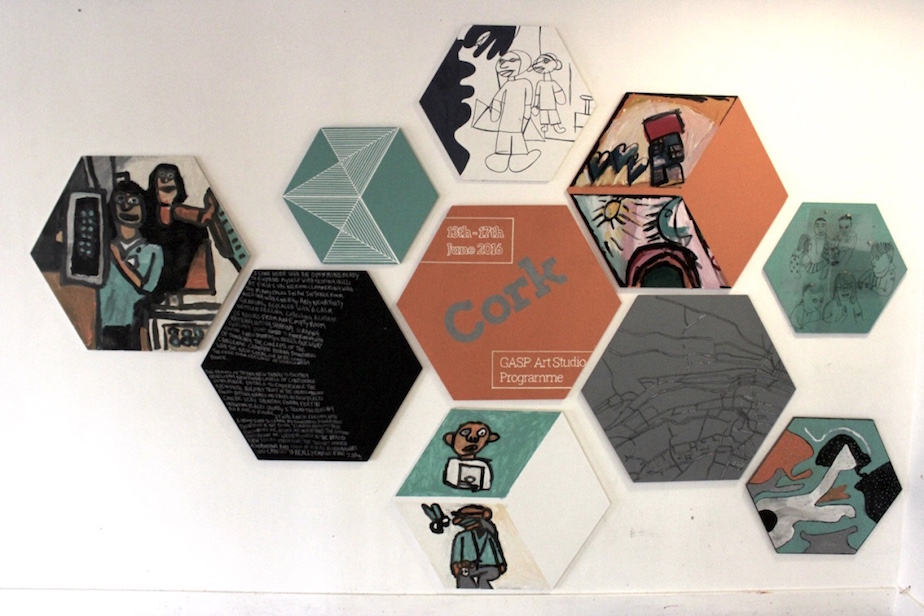
Presentation of Expanding Realities workshop timeline in Perceptions 2016 Exhibition Sept – Oct 2016
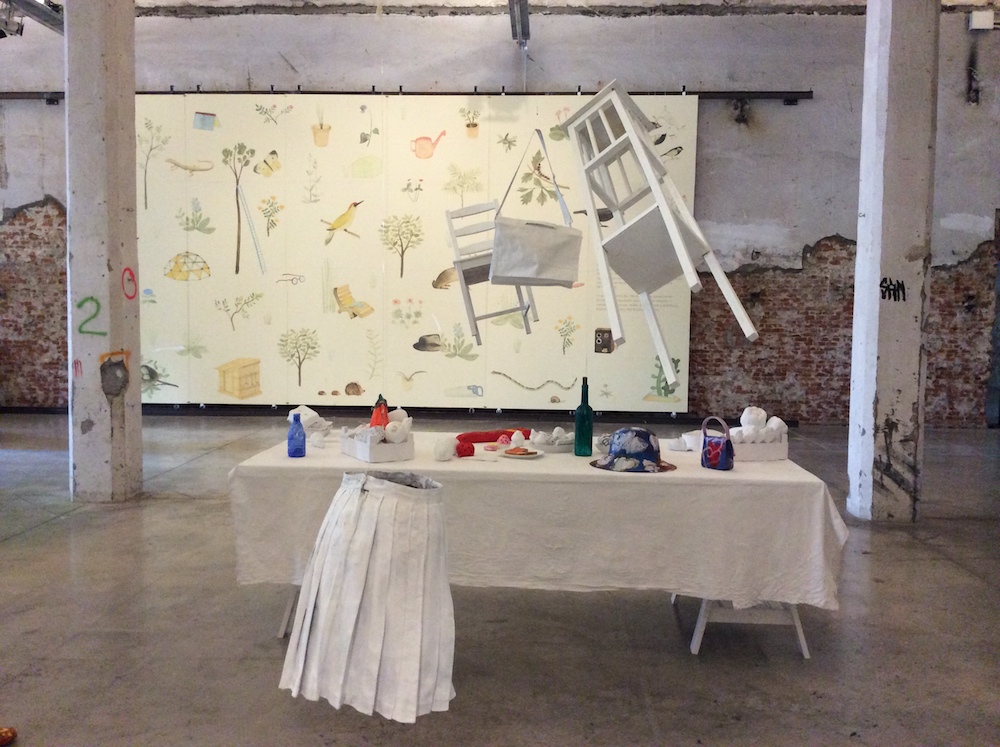
In White installation in Madrid, May 2015.
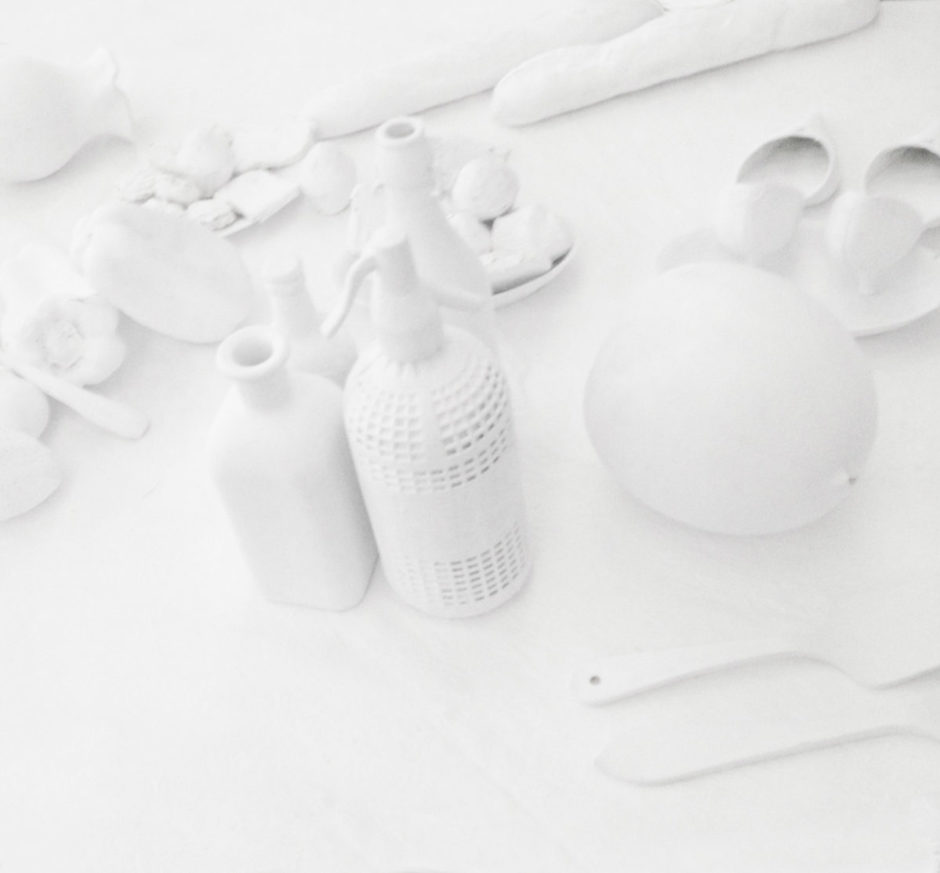
In White installation in Perceptions 2016 Exhibition Sept – Oct 2016
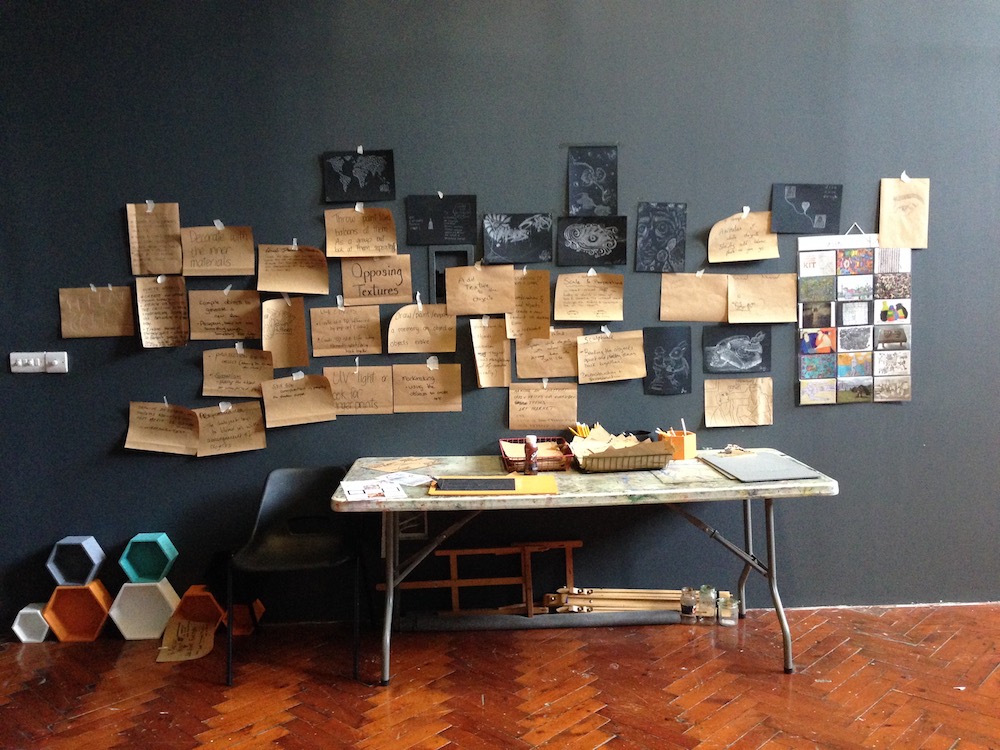 PME students brain-storm of ideas for adapting pedagogical concepts of the ‘In White Installation’ to their work in the classroom.
PME students brain-storm of ideas for adapting pedagogical concepts of the ‘In White Installation’ to their work in the classroom.
About ‘In White’
The participating artists and collaborators from Debajo del Sombrero prepared the installation “In White”, prior to the arrival of the visiting partners. The installation was a set of objects e.g. clothes,
shoes, chairs, bread, fruit placed on a table with a white tablecloth and suspended from the ceiling, all primed in white. The visitors were welcomed by the sight of the installation and the Debajo del Sombrero participating artists and collaborators as soon as they entered the space. Following on through the space, beyond the installation was a table well resourced with good quality materials, e.g. paint, brushes, markers, pencils all laid out clearly visible as an invitation to use. There was also an arrangement of tables and chairs spread out informally in the space. The installation was there to engage with throughout all five days of the workshop together. The installation served several functions alongside the symbolic role of reception, opening and beginning of something. It served as three-dimensional base on which to draw, paint and write, re-purpose or reinstall in different way or location. It served to bring the unknown to participating artists. It was neutral, free from preconditions, requirements or limitations. That reinterpretation of meanings was what Debajo del Sombrero sought to offer. With this installation, an open space was created in which the collaborators, could pick up the languages and interests of the artists and adapt to the unpredictable situations that come with
each individual participating artist. Throughout the week the installation served as a backdrop in the space not only for those directly involved in the process, but for the many people who visited and passed through the space as well.
Student engagement with ‘In White’
The students were invited to consider the process that took place in the workshop and to consider the pedagogical intention. They then were asked to consider how they could use the start of the process, the presentation of the installation to students as a starting point how they could develop work with their students.
The experience to engage with the work of the supported studios was a stimulating experience for the students. They came up with a wealth of ideas about how they could adapt, adjust and apply the experience. They effectively recognized and drew on principles presented in the workshop.
Below is the feedback from Art education lecturers on the experience.
What relevance did you find in Expanding Realities and Perceptions 2016 and the workshop to your objectives for the Student teachers?
The Professional master of education (Art & Design) requires students to engage in critical pedagogy and to consider alternatives to mainstream art and design education. Part of this is to examine alternative pedagogies and settings, considering how equality and inclusion is established so as to be mindful of overcoming the ‘one size fits all’ axiom. This exhibition and workshop highlighted not only the importance of redefining and ‘expanding’ their reality of what and how they teach, but also the energy, vibrancy and creativity that is truly achieved when these collaborations, approaches and settings are engaged in by all participants.
What unique learning opportunities did it offer?
It provided a lively forum for interacting with a facilitator artist / consultant who was able to provide valuable insight into the role that artwork and international creative forums can have on differently abled artists. Viewing that artwork and videos of the creative sessions provided potential for our students to expand their understanding of arts in a supported studio space and how there may be some overlap and connections with mainstream education. The brainstorming and critical reflection activities dovetailed well with our students experiences of 2nd level teaching and therefore they were able to see the potential to transfer understanding and knowledge from one arena to another
What are the key things you hope students will take away?
That art and inclusion should be indivisible from one another and that anyone, no matter what difficulties and disadvantages that they face in life, are valued and respected. Also, that the freedom and inhibition that differently abled artists show and how real expression is possible, will act as an inspiration for our students to explore new ways of thinking about creativity.
Do you see any potential possibilities or benefits for your students (or other students in CIT CCAD) to interact/collaborate directly with some of the artists in supported studios?
Possibly as part of the required research component in year 2 of the PME (Art & Design) programme, students may choose a non-mainstream setting for conducting and gathering data that may lead to a complete research paper for form part of a study that takes place in a secondary school.
Engagement with Master of Arts Art in Process
The students of the MA:AP programme had the opportunity to see the work of the studio group and it’s presentation and pubic engagement programme in the Crawford Art Gallery during Perceptions 2016
The focus of their visit was about what they could learn from the work of the supported studios and the Crawford Art Gallery Education programme that would support them in engaging with audiences of their own MA exhibition

Engagement with MA in Art Therapy Students
Interview with Ed Kuczaj – Head of Department of Arts in Health & Community Practice
Do you want to start by telling me where you got the idea to invite the Cuig artists into the Department?
The idea came from my experience of working with people with learning disabilities many years ago in relation to art therapy, but also in relation to art making. There was a connection with Mayfield Arts Centre, where the Cuig artists are based, and Jessica Carson and the Department.
The initial venue was a previous Department location, the O’Herlihy building..
Yes it was. And I know that it was around that time that Jessica asked me to go on the board of Mayfield Arts, which I did, and they were interested in what connections there may or may not be (or could be). The idea of some kind of studio connection came up. So the artsts were invited to come along to the O’Herlihy building on whatever morning to do their studio practice and it was put to the students that they could participate aswell. And that was an interesting success. Not all of the students took part, but there were a number of them that did. The bigger response came from the Cuig group or from Mayfield regarding the group’s interest in being in a college building and just being with the students. So then that subsequently moved to Sullivan’s Quay when our Department moved into town.
And did the Cuig artists come to Sullivan’s Quay aswell?
Yes. This was before GASP. And that ran on a similar framework so basically the students engaged with their own studio practice and bounced off the ideas of the Cuig group and vice versa. This lasted for year or two. So they would have worked with two or three different student groups.
Then what came from Mayfield was that they were interested in developing it a little bit further and there was a suggestion that the students and the Cuig group would offer each other workshops using different techniques or whatever. Which they did and I know there was one particular group of students where there were only eight of them and they all participated for at least a semester running workshops. They also introduced the idea of the students going to Mayfield to experience workshops there, which they did. That was all fine, but what happened was that it changed to, not to tuition, but it changed the dynamic so they weren’t coming for the studio practice. They were coming to engage with a specific project. For the students it changed (although it was still interesting) because they were having to think of constructing a workshop for the studio group to be involved in. So it moved it away from the idea of studio practice and it started to dwindle out after that.
It was at this point that the GASP artists started coming in through Hermann Marbe who was interested in giving his group a similar experience. The difference with GASP was that they were coming on a day that the students weren’t actually there so the number of students who participated in that was quite limited, but there were one or two. It did allow other people to get involved so in addition to the one or two students there were some foreign students and also people who were involved in voluntary work with Hermann. It opened it up very differently.
I suppose what was interesting then with the GASP artists was that that started to move down a similar route in that Hermann and, you know whoever, was interested in there being some kind of projects, some kind of engagement, and teaching (for want of a better word). So the artists and students might experience printmaking or how to do a certain technique. But that was something that happened in the session rather than took over the session so its impact wasn’t as great as it had been with Cuig. This difference allowed the group to continue.
It continued, but what happened was that there was less involvement from the students because we couldn’t force them to come in. It poses a number of questions about whether you just rely on this being voluntary. We did open this to the students in the rest of the college, not just the Art Therapy students. I know one or two students from the Fine Art course came to it, I think on the basis that they were thinking about doing art therapy in the future so were thinking this was part of it, but obviously wasn’t.
So, it was offered out, but wasn’t really taken up…
Yeah and I think there is a question there around do you offer something which is part of a programme and make it mandatory or specifically encourage people to come along, or do you leave it as this free experience that people come to and gain something from? I think the bottom line though is, regardless of what the needs are of the students (and I think their engagement with it is really useful and should be encouraged more), is the other end of it in terms of the benefit it gives the GASP artists or the Cuig artists in relation to their engagement with a studio experience. The only reason that the Cuig artists and the GASP artists were able to come into the college was because we facilitated it and our building wasn’t part of the main college and that is the bottom line.
And the space was there to make it possible?
Yeah. Nobody was going to complain that the space was needed by somebody else because it was our space so we could do what we wanted with it. If you tried to do that in somebody else’s space, it probably would have been more limited. But the other benefit of it, particularly in relation to Sullivan’s Quay was an awareness by the rest of the college and the 4th year students who were based there that actually this work happened. And then if you think of the number of exhibitions there would have been by GASP downstairs – it probably wasn’t that many over the years, but it would have been four or five occasions where there would have been something on so people were actually seeing stuff from this alternative group which is really important in relation to their recognition.
So moving from here forward with our new Department location, in the absence of space or the challenge of space, what do you envisage?
Em… I suppose the minimum there could be because there is a major issue around space (there are no two ways around that) is that the relationship the college has with these two groups should be maintained. So how do you go about that?
It is going to be difficult to incorporate them in the mainstream part of the week because of the space issues but it does leave opportunities in relation to the rest of the year, like the summer or whatever. It isn’t ideal because it dilutes the relationship, but it would be better to have that relationship than no relationship. So there is a questionmark about the use of space outside of the time it gets used.
I think the other thing is around exhibition space, you know, and how that can be offered to those groups. I don’t think they should be offered preferential treatment in terms of access to that space, but they should be regarded as being equal to anyone else In terms of deserving the use of that space based on any proposals they put forward. So there is something about how the college allows for that and accommodates that.
There is also something about the work those groups are involved in, how that gets formally translated and communicated to students on the course. So whether there are elements within a course, whether it’s the proposed MA, the Art Therapy MA, the Arts in Group Facilitation Cert, where you have already begun to bring those groups in to engage in work specifically on a project or whatever. So I guess that is a third way.
Well there is certainly potential to bring them in, and bringing them in on the Arts in Group Faciltiation Cert worked really well.
And then the other thing is what happens, or doesn’t happen with the exhibition “Perceptions” in 2019. If that is something which is part of the college then there is a whole bunch of educational stuff which could happen there. That then leads into, or relates to the idea that has been floated around in relation to a studio module, you know where somebody gets credit for their engagement in studio practice. On its own that is possible. It would however seem to be easier to locate that within a course like the MA in Inclusive Arts Practice because that gives it a meaning and ways for it to be held.
The problem with doing something loosely based around the idea of studio practice is that it requires energy and a holding. Depending on the people who are faciltiating it, it either works or it doesn’t work because the individual artists won’t come of their own volition. Even the quality of what happens in terms of people’s engagement is totally dependent on the facilitators. What you notice quite often is the way that facilitators come to it with their own intention and their own creative desire (subconsciously) which is understandable…
That that influences the outcomes?
Yeah. It becomes more collaborative without them even realising that that is the road they have gone down. So that is why it requires a lot of work because it actually poses more questions than it potentially solves.
But I suppose that is interesting as well, interesting material for the Department to explore.
Yeah, because I don’t think we are looking to give answers. I don’t think we should be.
Engagement with Arts and Group Facilitation programme
The Arts in Group Facilitation Certificate trains practitioners to work in social contexts as arts-based facilitators. The GASP artists worked with the 2015 and 2016 intake of students on this course, sharing skills in a studio setting. Two of the artists were supported by facilitator, Hermann Marbe, to show their work and demonstrate their process. The students on the course then worked with the artists for a day in an open studio setting. The 2016 year group also participated in a workshop with the Cuig artists as part of the Perceptions 2016: The Art of Citizenship exhibition.
Students were asked for feedback on their experience of engaging with the artists through these workshops. The questions and selected responses are compiled below:
What did you learn from the experience – personally and as a facilitator?
I had the privilege of developing an even broader view of just how inclusive and creative such projects can be. My own ideas on creativity, care and inclusion, were enhanced hugely. To simply have witnessed the joy derived by the participants and facilitators, in engaging with such a vast scope of creative efforts and activities, both as individuals and collaboratively was hugely inspirational for me in the most personal of senses.
I must say that I enjoyed it immensely. It was a new learning curve for me. Learning those new techniques and engaging with the Gasp artists.
I loved the time we spent with them; the way all of us relaxed over the short period and enjoyed the exercises, especially as they invoked laughter amongst us all.
I didn’t see the artists as disabled. When in their company, I felt inadequate as an artist and humbled by their welcome and acceptance of me who was there to learn, experience by observing and working alongside them. The two workshops with the GASP artists made a great impact on me, seeing their different approaches, points of view, pride in their work, quality and diversity of their creations and in a very short length of time I belonged. I did not see their disabilities.
Throughout my time volunteering with GASP, and through the Arts in Groups Facilitation course I witnessed others have the same jumbled up initial feelings of awe, guilt, shame and anger, sometimes even tears. It is difficult to separate the work from the story of the person making the work.
My experience, taught me that the role of emotion cannot be underestimated when initially meeting artists with disabilities. I believe that this emotion is to be expected, factored into and accommodated in workshops/volunteering/facilitating/studying. That is a complex task as, traditional notions of ‘balance of power’ are disrupted, no one size fits all, and experiential learning is central to understanding the dynamics of relationships.
By simply watching and listening to the artists and being in their space inspired me to get over my initial inhibitions of getting something right and to just play. With my own ideas. No right or wrong. I felt it was very generous of them to share so much of their style and technique, unafraid that we would try to re-create it. To me it shows the passion they have for their work.
What did you notice about approaches to working and how this compared with other workshop experiences on the course?
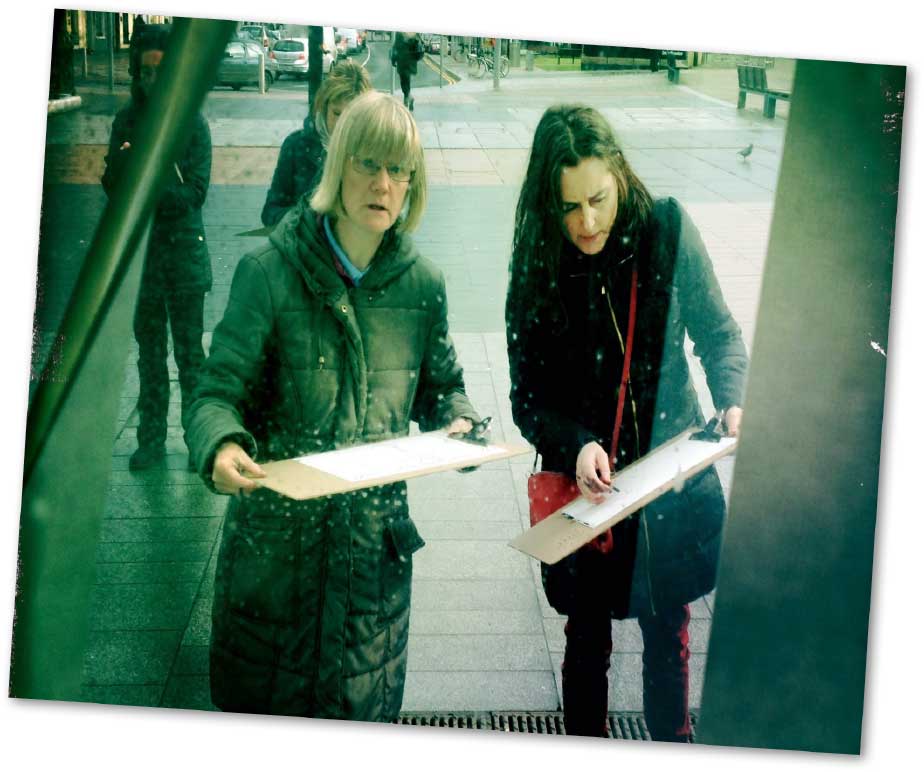 Even having experienced these exercises before did not diminish the fun, curiosity about what transpires or the excitement. This group was filled with energy and there was a lot of laughter. The artists from the supported studio were open and participated freely and confidently and mingled well with all of us students.
Even having experienced these exercises before did not diminish the fun, curiosity about what transpires or the excitement. This group was filled with energy and there was a lot of laughter. The artists from the supported studio were open and participated freely and confidently and mingled well with all of us students.
The quality of the work, the self-determined nature of the participants’ creations, the interactions and exchanges of ideas, and the opportunity to have in some small way been allowed myself, to access and take inspiration from these endeavors will be an immensely valuable and enriching experience for me.
Chatting to them about their work. Working alongside them, engaging with them. There was a facilitator. We were the participants and so were the Gasp artists. I learned a lot from them just by working together.
It was a good idea to put all of the art work out together to see all of the different styles and how the various characters of each person were illustrated. It celebrated the differences and similarities in a lovely way and you could not tell which pictures were made by whom.
Compared to the other workshops the facilitation style was very different. Many of the other workshops were packed with content, proceeded at an almost manic pace and with a high energy facilitation style to keep things moving, Most of the workshops made serious demands on the energy and concentration of the group. In contrast the Gasp Artists day seemed more of a recreational experience. The facilitator had a fairly quiet, low key approach which put people at ease and there was a relaxed feeling to the day. As I recall it, the group didn’t know beforehand what this day was going to be about, but there seemed to be a general expectation that it would not tax us too much, compared to the previous workshops.
Any suggestions for developing the engagement within the course.
The one thing I will say that was very positive was working and interacting with the GASP artists in the Cork Printmakers Gallery. This was an external venue and it helped dissolve the projections-introjections which would normally take place if I were facilitating in a centre such as RehabCare/Caritas/Brothers of Charity. I would certainly advocate more of that.
When we were being facilitated by the facilitator and the GASP artists, the facilitator did nearly all the talking/facilitation; the GASP artists were simply there, quietly doing their own thing-perhaps it would be an idea if they were more ‘present’ and involved in a more active, interpersonal way during this facilitation.
While there was a good atmosphere and everyone seemed to enjoy the day, maybe there are some things that need to be looked at. For one thing, the format did not create much interaction between the Gasp Artists and the group. Would it be possible to start the day with an introductory session, perhaps a talk by the facilitator on the origin of the Gasp Artists, their challenges, progress and achievements to date and where they were headed? This could also touch on the subject of Arts and Disability in general including how it is developing in other countries [as your Project has an international dimension]. Maybe this talk could be illustrated with a slideshow of the Artists work, exhibition openings and so on. The Artists could be introduced during this talk and might be happy to comment on the slides or talk about their work. This could conclude with a Q and A session which could start some level of interaction.
Would it be possible to devise an activity that had Gasp Artists and the group working together for a while, maybe on a group piece with a relevant theme?
Another possibility; the Artists were using some interesting techniques, one drew everything with thick charcoal lines as a foundation to paint over. This produced really strong and graphic compositions. In contrast to that was the use of tea or coffee in lieu of paint to make paintings that were more delicate and subtle. Although these techniques were described on the day, it would be more powerful if they were turned into exercises done back to back and taught by the Artists to the group.
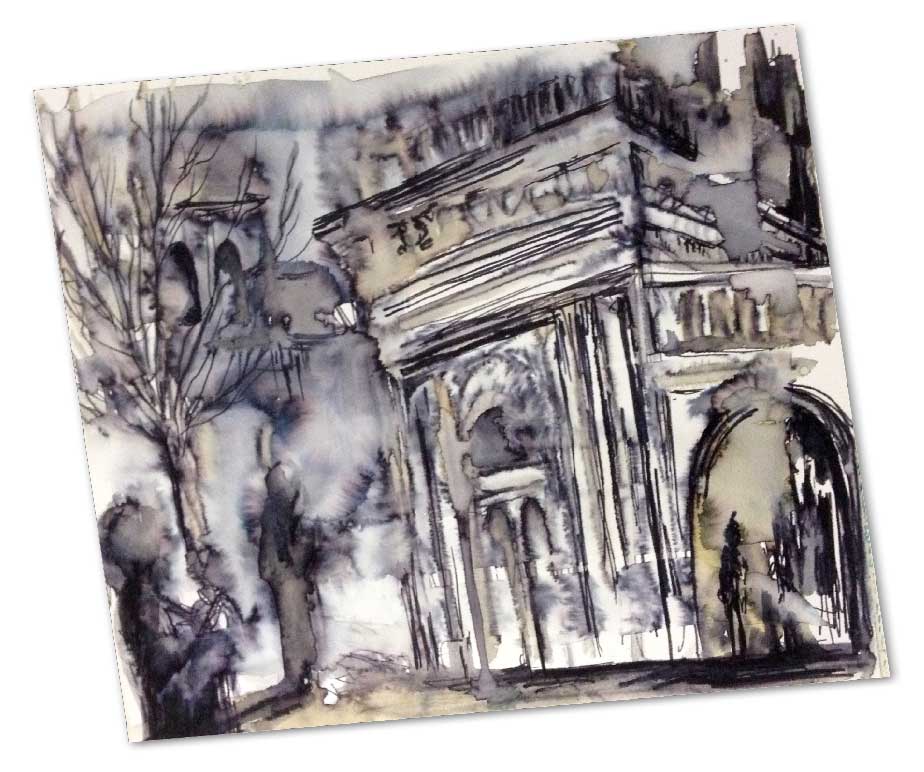
Although we were given interesting painting activities to do during the day, by the afternoon the energy had dissipated, as we had been sitting still for too long. That might be avoided if the day had a different structure, with time slots allocated for information and discussion, teaching and creating, individual and group work.
This Workshop could be more effective, in my view, if changes were made to the structure and content to reflect clear aims. The style of facilitation does not have to change, as this is what gives the Workshop its special character.
Anything else that comes to mind.
I can only hope that I have further opportunity to interact with such projects, and to witness more creative and inclusive efforts, such as Expanding Realities was.
A point comes when there is a respect for the artwork and it is very clear that creativity is inherent in everyone, abled or disabled. The distinction lies in the person’s want, need or ability to recognise and express their creativity. I believe that the want/need to share is a huge step for the artist with a disability and is inextricably linked to a trusting environment.
I experienced for myself, and witnessed others value working/studying with the GASP artists. There is a very real appreciation of what artists with disabilities have to offer the student/other artists especially at professional or 3rd level. There is a growing appreciation of the need to include people with disabilities in society. To be inclusive is not just to accept diversity. True inclusion values diversity. In valuing diversity we have to enable that which diversity has to offer. Systems as they are, may not allow for that enabling. If we accept that artists with disabilities are making Art, then Art schools and colleges have a particular role to play in actively progressing the ability of artists with a disability to study and/or practice art.

